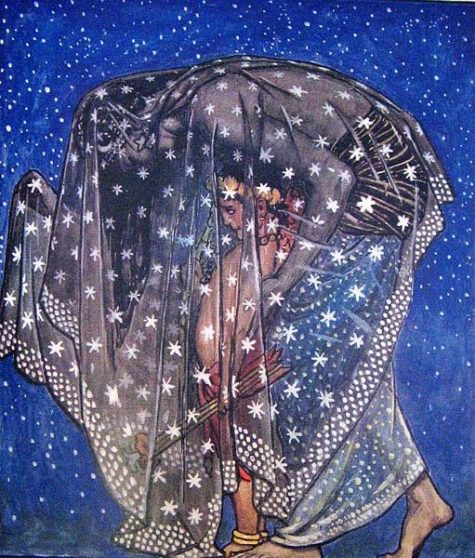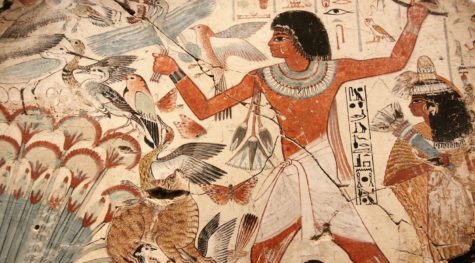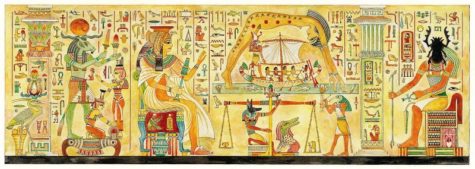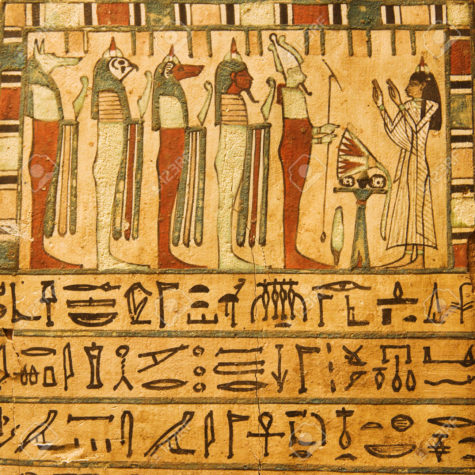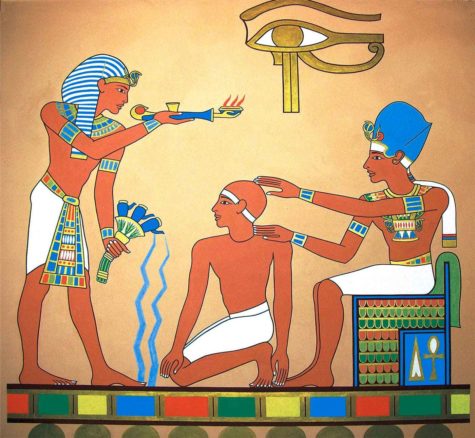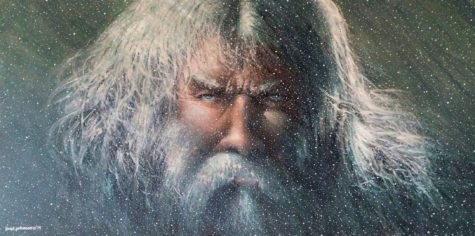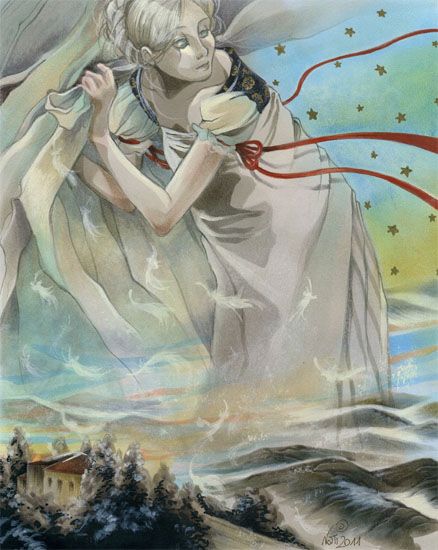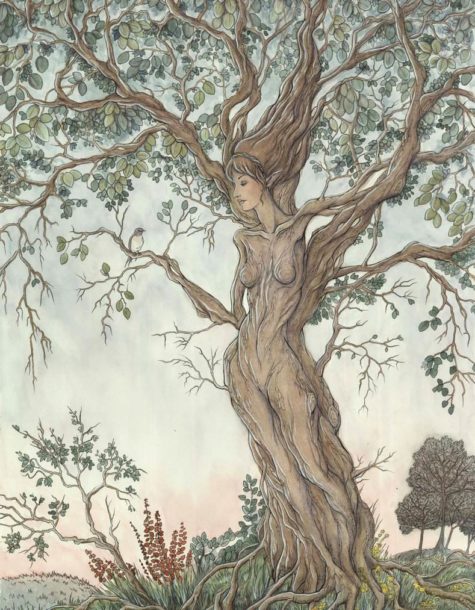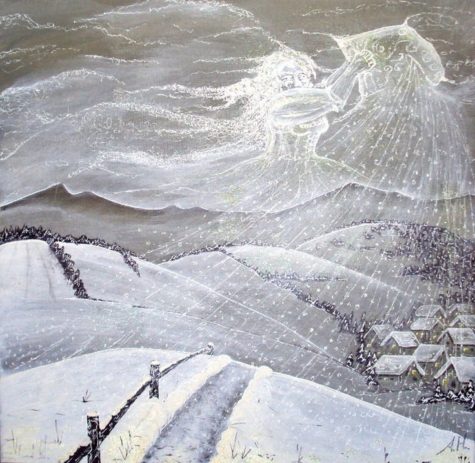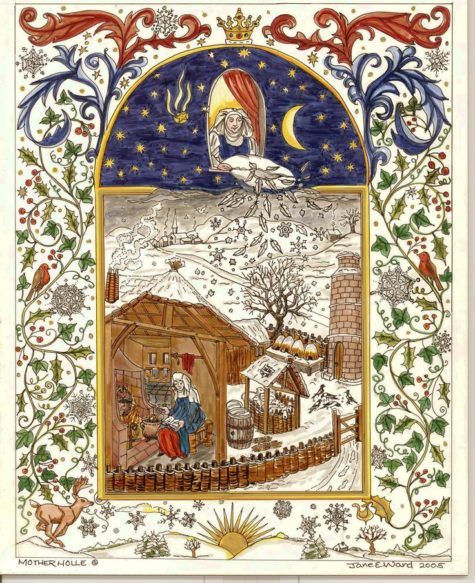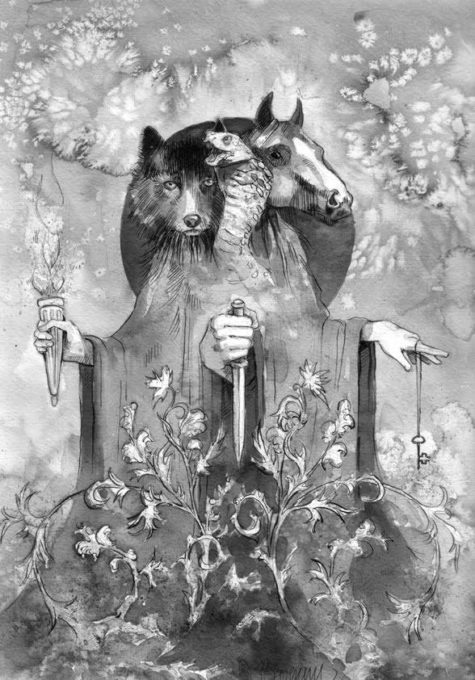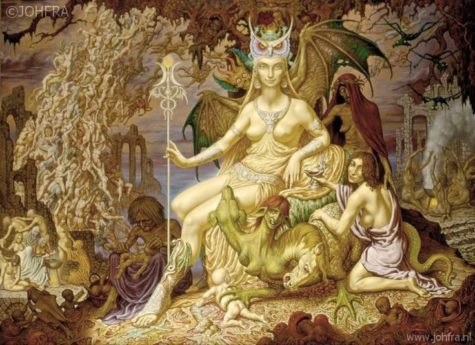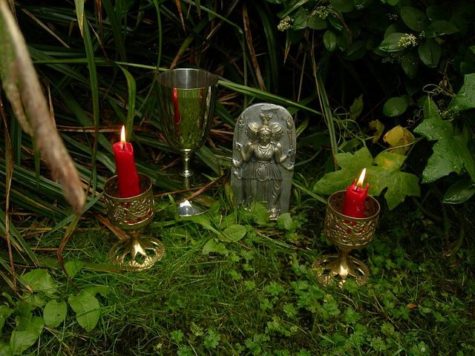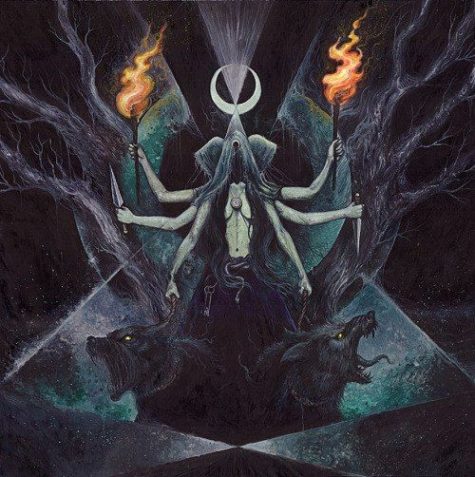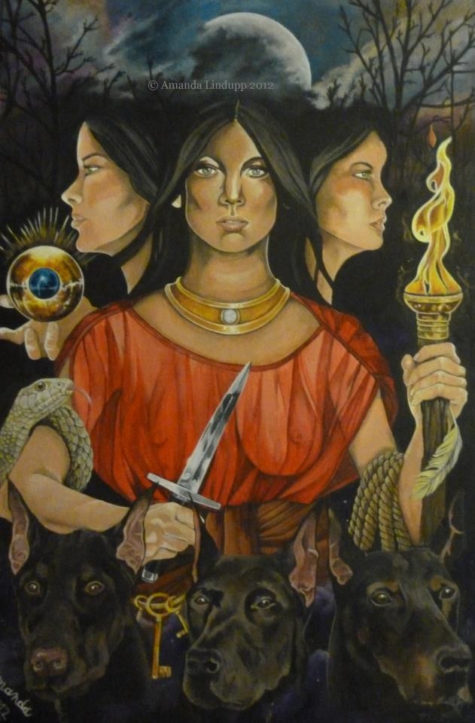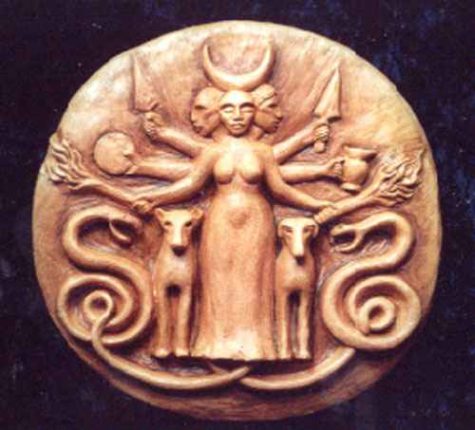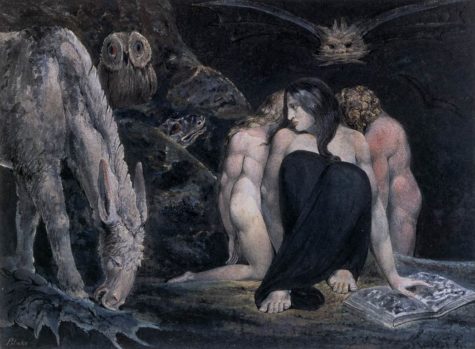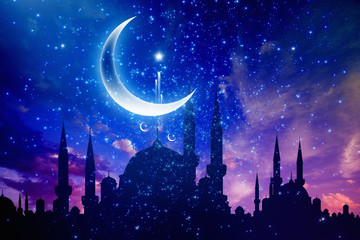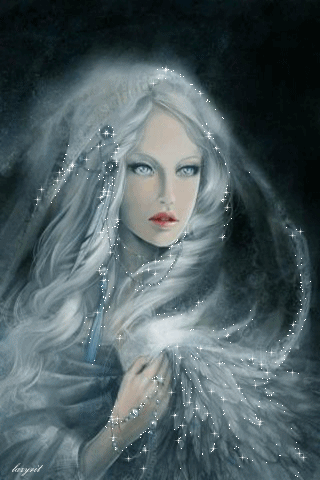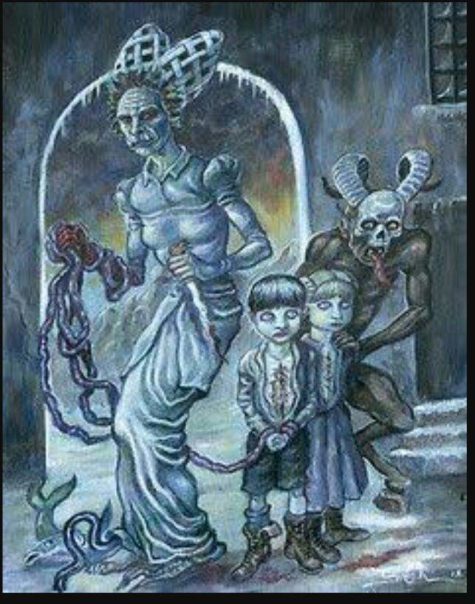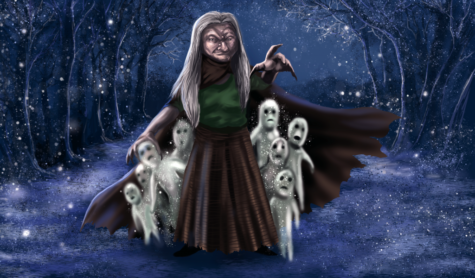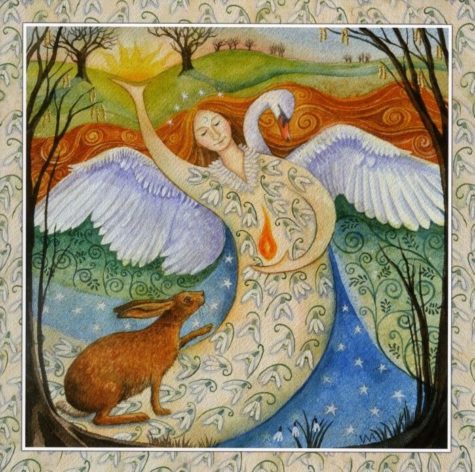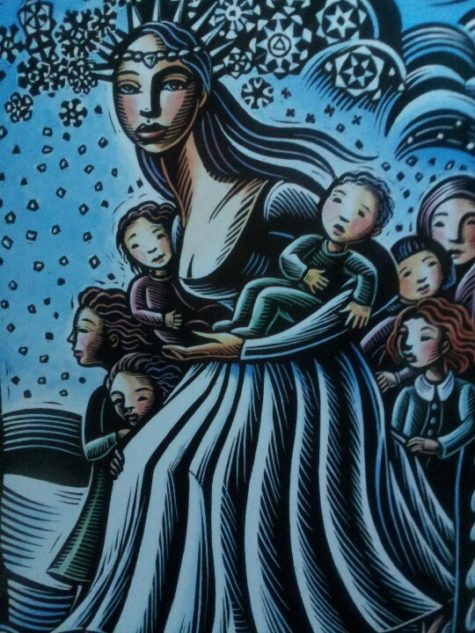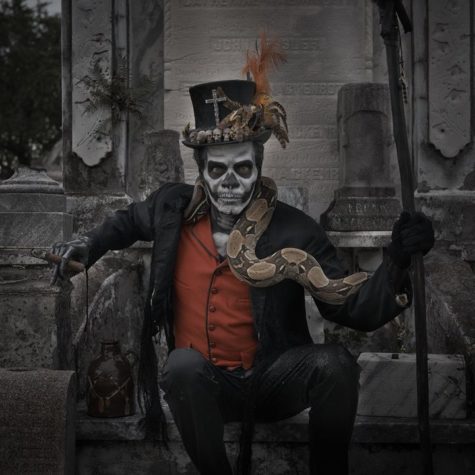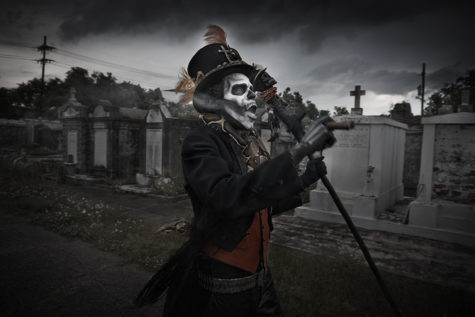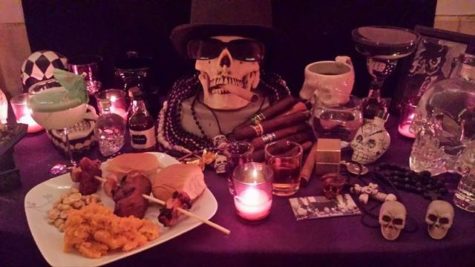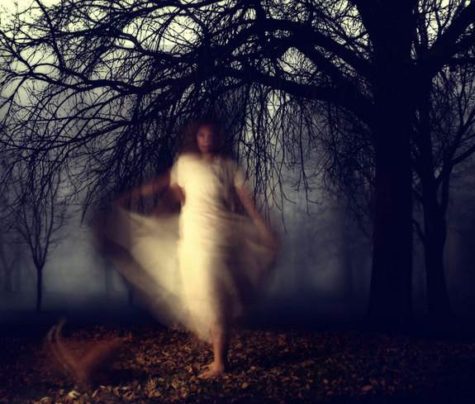Yearly Archives: 2017
- Names: Nit
- Attributes: Two arrows and a shield, shuttle
- Creatures: Crocodile, snake, bee
- Color: Green
- Plants: Flax, papyrus
- Favored people: Soldiers, hunters, weavers, artisans
The inscription on Neith’s temple in Sais in the Nile Delta (now modern Sa el-Hagar) read:
I am all that has been,
that is and that will be
No mortal has yet been able
to lift the veil that covers me.
Neith, the First One, the primordial goddess, was never born but always existed. Alternatively she is completely self-generated. Neith traveled from the deserts and oases of Libya to emerge as among the greatest of Egyptian goddesses. In one Egyptian creation myth, Neith brought forth Ra, the sun. Then she invented the shuttle and loom, put the sky on her loom, and wove the world into existence. Neith, the first to give birth, invented weaving. Her name may derive from a word for “to weave” or “to knit.”
She is called:
- The Oldest One
- Nurse of Crocodiles
- The Huntress
- Opener of the Ways
- Great Goddess
- Lady of the West
Mother of the Gods, goddess of war and the hunt, she is goddess of the lower heavens, a warrior goddess and protectress. Her name means “I have come from myself,” or self-begotten.
Eternal goddess, universal mother; the Spirit behind the Veil of Mysteries; World Body; Primal Abyss. Her cult was a very ancient one with two queens of the First Dynasty named after her. Often shown along side Selqet as mummy guardian and protectress of marriage. She wore the red crown of Lower Egypt. In her hands she held a bow and two arrows.
Neith is a goddess of hunting. She presides over crafts of all kinds, including witchcraft and warcraft. Amuletic weapons placed in the tomb to protect the deceased from evil spirits were consecrated to Neith. She is the judge of the Egyptian deities. After eighty years, when the lawsuit between Horus and Set in the Court of Deities was still not resolved, Neith was called in to render a decision to which all could defer. (She favored Horus but compensated Set. Neith has historically had a close positive relationship with Set.)
Her ceremonies were of a mystic nature. Neith was worshiped with Mysteries and lantern processions. In December (on or around December 8th), a great festival, called the Feast of Lamps, was held annually in her honor and, according to Herodotus, her devotees burned a multitude of lights in the open air all night during the celebration.
She is the patroness of domestic arts, weaving, hunting, medicine, war, and weapons. Turn to her when working with herbs, magick, healing, mystical knowledge, rituals, and meditation. She is the protectress of women and marriage.
She may be venerated independently or together with her son, Sobek. The Greeks identified her with Athena, also identified as originating in Libya. Many consider Athena to be a Greek path of Neith or at least a very closely related spirit.
Neith appears as an androgynous woman. She wears the red crown of Lower Egypt. She sometimes appears in the guise of a golden cobra, as well. In Iconography, she is customarily depicted with a green face and hands. Neith is portrayed suckling a crocodile at each breast.
The main imagery of Neith was as the deity of the unseen and limitless sky, as opposed to Nut and Hathor, who respectively represented the manifested night and day skies. Her epithet as the “Opener of the Sun’s Paths in all her stations” refers to how the sun is reborn (due to seasonal changes) at various points in the sky, under her control of all beyond the visible world, of which only a glimpse is revealed prior to dawn and after sunset.
It is at these changing points that Neith reigns as a form of sky goddess, where the sun rises and sets daily, or at its ‘first appearance’ to the sky above and below. It is at these points, beyond the sky that is seen, that her true power as the deity who creates life is manifested.
This ancient goddess represents the full ecliptic circle around the sky (above and below). It was this realm, the cosmos below the horizon, that Neith personified, for she is the complete sky which surrounds the upper and lower sky, and which exists beyond the horizon, and thereby beyond the skies themselves. Neith, then, is that portion of the cosmos which is not seen, and in which the sun is reborn daily, below the horizon which may reflect the statement assigned to Neith as “I come at dawn and at sunset daily.”
As the goddess of creation and weaving, she was said to reweave the world on her loom daily. An interior wall of the temple at Esna records an account of creation in which Neith brings forth from the primeval waters of the Nun the first land. All that she conceived in her heart comes into being, including the thirty deities. Having no known husband she has been described as “Virgin Mother Goddess.”
Unique Goddess, mysterious and great who came to be in the beginning and caused everything to come to be . . . the divine mother of Ra, who shines on the horizon…
Sources:
This is a by no means complete list of the animals, mortal and supernatural, that were sacred to the ancient Egyptians, along with the deities they were considered to be sacred to. Pictures or statues of these creatures used during rituals will enable the subconscious mind to make a better link, thereby enhancing the ritual’s power.
- Asp – Buto
- Ass – Set
- Ape – Thoth
- Bull – Ptah, Menthu, Min
- Cat – Bast, Mut
- Cobra – Buto
- Cow – Hathor, Sati, Mut
- Crocodile – Sebe, Set
- Dog – Anubis
- Frog – Heqet, Hathor
- Goose – Amen-Ra, Seb, Isis
- Hawk – Osiris, Horus, Ra, Seker, and others
- Heron – Sacred in general
- Hippopotamus – Ta-Urt, Set
- Ibis – Thoth
- Jackal – Anubis
- Lion – Sekhmet, Mut
- Lynx – Benevolent Spirit
- Phoenix – Osiris
- Pig – Set
- Ram – Ba-Neb-Tetet, Khnemu
- Scarab – Khepera
- Scorpion – Selqet, Set
- Serpent – Apep, Buto, Renenet
- Shrew-Mouse – Buto
- Sphinx – Ra-Temu
- Swallow – Isis
- Tortoise or Turtle – Enemy of Ra
- Vulture – Nekhebet, Mut, Neith, and others
- Wolf – Wepwawet
The deities listed here are by no means all those recorded in the Egyptian pantheon. It would be impossible to list them all. Anyone interested in an in-depth study of Egyptian deities should read The Gods of the Egyptians by E. A. Wallis Budge. Also there are vast differences in the spellings of Egyptian deity names. This is because Egyptian hieroglyphs had no vowels.
This is a simple list of Egyptian gods and goddesses from Egyptian mythology, along with their titles and some of their attributes. The ancient Egyptians worshiped many gods at different times and in different places. Some gods changed in importance over time.
A
Aebehout (Kebehet, Kabachet, Kebhut, Kebechet, Qebhut, Qeb-Hwt) – Goddess of the Water of Life. The goddess of purification, also is known as the wandering goddess or the lost child, she presides over the magical reviving power of water.
Amaunet (Amunet) – Goddess of Heaven, Wife of Amun. (see also Amonet)
Amen (Amoun, Amun, Amon, Ammon) – The Hidden One; Lord of the Libyans; Lord of the Setting Sun and Moon; The Time Lord; Earth Father; Giver of Breath; Giver of Life, Vizier of the Humble, Who Answers the Voice of the Poor. The great god of Thebes of uncertain origin; represented as a man, sometimes ithyphallic; identified with Re as Amen-Re; sacred animals, the ram and the goose.
Ament (Amenti) – The Westerner; The Hidden Goddess; Goddess of the Land of the West; Goddess with Beautiful Hair. She welcomed all deceased people to the land of the dead with bread and water. (see also Amonet)
Ammit (Ammut, Ahemait) – The Eater, Devourer of the Dead; Eater of Hearts; Bone Eater; Devourer of Millions; Greatness of Death. This is the crocodile goddess also known as Ammit the Devourer. She also assists Anubis with carrying out the Judgements,
Amonet (Amunet, Amaunet, Ament, Imentet, Amentat) – The Mother Who Is Father. A primordial spirit composed of the two deities Ammon and Ammit.
Amun-Ra (Akmun-Ra, Ra, Re, Phra) – The Creator; The Supreme Power; The Only One; Great Father; Father of the Gods; Sun God. Ra is the god of the Sun, head of the great ennead, supreme judge; often linked with other gods aspiring to universality, and king of the gods until Osiris took over his throne.
Anat (Anath, Anta) – The Girl; Lady of Heaven; Mistress of All Spirit; Strength of Life; Lady of Mercy. A goddess of Syrian origin, with warlike character; represented as a woman holding a shield and an axe.
Anhur (Anher, Anhert, Onouris) – Skybearer, The Divine Huntsman. Very early aspect of Osiris, God of war, sun and the sky.
Anput – Goddess of the seventeenth Nome of Upper Egypt
Anubis (Anpu, Sekhem Em Pet) – Foremost of the Westerners. He is god of judgement of life and death, the jackal-god, patron of embalmers; the great necropolis-god.
Anuket (Anqet, Anukis, Anoukis) – The Clasper; The Embracer; Bestower of Life; Lady of Nubia. She is the goddess of river Nile and the cataract-region at Aswan; wife of Khnum; represented as a woman with a high feather head-dress.
Apep (Apophis) – The chaos snake. Demon enemy of the Sun, the eternal enemy of Ra. He is a god of chaos and war.
Apet (Opet, Tauret, Taurt, Thoueris, Rertrertu, Taweret, Ta-Urt, Tauret) – Mistress of Talismans. The hippopotamus goddess, a beneficent deity, the patron of woman in child-birth and goddess of fertility. In her darker aspect she was the goddess of darkness and revenge.
Arsaphes (Herishef)- A ram-headed god from Heracleopolis.
Apis – A live bull worshiped as a god at Memphis. This is a rare case of an animal being worshiped as a god while alive, then mummified when he died.
As (Aset, Eset, Tait, Isis) – Supreme Egyptian Goddess, Great Mother, Giver of Life.
Astarte (Ashtarte) – Lady of Heaven; Mother of the Blessed. A goddess of Syrian origin; introduced into Egypt during the Eighteenth Dynasty.
Atem (Atum /Temu, Tem) – Dark Eye of Ra. Personification of God in human form and of the setting Sun. Father of the human race, he helped the dead. In one of his forms he was worshiped as a huge serpent.
Aten – The disk of the sun Originally an aspect of Ra
Athor (Athyr, Hert, Hat-Hor, Hathor) – The Great One of Many Names; The Golden One; Lady of Malachite; Lady of Turquoise; Sady of the Sycamore; Lady of the Date Palm; Lady of the West; Lady of the Dead; The Womb of Horus; House of Horus; Lady of the Evening; My House in the Sky; Lady of the Uterus; Lady of the Vulva; The Womb Above. This popular goddess is the matron goddess of all women, the embodiment of the female principle. She has many functions and attributes.
Auser (Osiris)- Lord of the Far World. Osiris is the god of the underworld and the afterlife. He is identified as the dead or mummified king; also a god of the inundation and vegetation.- Lord of life after death, Sun god, Universal Lord
Au Set (Isis, As, Aset, Eset, Tait) – The Great Lady; Queen of the Earth; Light Giver of Heaven; Mistress of Magic; The Many Named; Queen of the Throne; She Who Is Rich in Spells; Great of Sorcery; Redemptress: Star of the Sea; The One Who Is All; Mother of Gods. Isis is the divine mother, goddess of magic, marriage, healing, and motherhood. She is the wife and sister of Osiris and the mother of Horus. She is one of the four ‘protector’-goddesses, guarding coffins and Canopic jars; sister of Nephthys with whom she acted as a divine mourner for the dead. Supreme Egyptian Goddess, Great Mother, Giver of Life
Auf (Euf Ra) – Aspect of the Sun god Ra
B
Babi – God of baboons
Ba-neb~Tetet (Banebedet, Banaded, Banabdedet, Banabdjedet) – The Soul of Mendes; Lord of Mendes; The Ram of Mendes. The calm cool headed ram deity who found a peaceful solution to the power struggle between Horus and Set. God of discussion, arbitration, peace.
Bast (Bastet, Pasht) – Mistress of the Oracle; Great Conjuress of the Casket. The cat goddess with dominion over sex, fertility, marriage, magic, music, childbirth, and the pleasures of life. Cat Goddess known to protect pregnant women and children. The protector of Ra, his third eye.
Bes – Dancing. Lord of the Land of Punt. Bes is the dwarf god with leonine features; a domestic god, protector against snakes and various terrors; helper of women in child-birth. Dwarf God God of Pregnant woman, newborn babies, and family also known to protect from snake and scorpion bites
Buto (Uajyt, Uatchet, Utchat, Per Uadijit, Uazrr, Uto, Uraeus) – Eye of Ra; Lady of Heaven; Lady of the North. At times she was portrayed as a cobra, sometimes winged, sometimes crowned. Goddess of protection, hiding from evil. See also Wadjet.
D
Djehuti (Zehuti. Thoth, Tehuti, Thout) – Lord of Divine Words; Lord of Books. Thoth is the ibis-headed scribe of the gods, the god of wisdom, inventor of writing. The ape as well as the ibis is sacred to him. Judge of the Gods.
E
Edjo (Buto, Wadjet, Udjat) – Goddess of protection. Sister of Nekhbet. Lady of Flame; Lady of the North; Lady of Heaven; Queen of Holy Spirits. The cobra-goddess of Buto in the Delta, a goddess of protection, appearing on the royal diadem, protecting the king.
Ernutet (Renenet, Renenutet) – Lady of the double granary, Goddess of the 8th month of the Egyptian calendar.
Eset (Tait, Isis, As, Aset) – Supreme Egyptian Goddess, Great Mother, Giver of Life.
Euf Ra (Auf) – Aspect of the Sun god Ra
G
Geb (Keb, Seb) – Father of the Gods. A fertility Earth god, similar to the Greek Cronus, always shown with erect phallus. Presides over fertility, new beginnings, creation, and crops.
H
Hapi – God of the Nile in inundation; represented as a very fat man. God of the Nile, crops, fertility, water, and prosperity.
Hat-Hehit – Fish-goddess of Mendes in the Delta; sometimes represented as a woman with a fish on her head.
Hathor (Athor, Athyr, Hert, Hat-Hor) – The Great One of Many Names; The Golden One; Lady of Malachite; Lady of Turquoise; Lady of the Sycamore; Lady of the Date Palm; Lady of the West; Lady of the Dead; The Womb of Horus; House of Horus; Lady of the Evening; My House in the Sky; Lady of the Uterus; Lady of the Vulva; The Womb Above. This popular goddess is the matron goddess of all women, the embodiment of the female principle. She has many functions and attributes.
Heh (Neheb) – God of eternity, longevity, and happiness. Shown as a man squatting on the ground wearing a curved reed on his head.
Heqet (Heqtit, Heket) – Midwife of the Sun, Giver of Life; Spirit of the Primordial Waters; Mother of the Spirits. She is the frog-goddess of Antinoopolis where she was associated with Khnum; a helper of women in child-birth.
Herishef (Arsaphes) – A ram-headed god from Heracleopolis.
Horus (Haroeris, Haru-Er, Harsiesis, Harpocrates) – The Enchanted One. Horus is the god of war, sky, and falcons. He is regarded as the son of Osiris and Isis, for the former of whom he became the avenger.- Falcon headed Sun and Sky God, Divine Child, reborn Sun
I
Imentet (Amentat, Amonet, Amunet, Amaunet, Ament) – The Mother Who Is Father. A primordial spirit composed of the two deities Ammon and Ammit.
Imhotep (I-Em-Hetep, Imouthes) – He Who Comes In Peace. The deified chief minister of Djoser and architect of the Step Pyramid; in the Late Period venerated as the god of learning and medicine; represented as a seated man holding an open papyrus; equated by the Greeks with Asklepios. God of knowledge, medicine, magick, compassion, drugs, herbs, sleep
Isis (As, Aset, Eset, Tait, Au Set) – The Great Lady; Queen of the Earth; Light Giver of Heaven; Mistress of Magic; The Many Named; Queen of the Throne; She Who Is Rich in Spells; Great of Sorcery; Redemptress: Star of the Sea; The One Who Is All; Mother of Gods. Isis is the divine mother, goddess of magic, marriage, healing, and motherhood. She is the wife and sister of Osiris and the mother of Horus. She is one of the four ‘protector’-goddesses, guarding coffins and Canopic jars; sister of Nephthys with whom she acted as a divine mourner for the dead. Supreme Egyptian Goddess, Great Mother, Giver of Life
K
Kabachet (Kebhut, Kebechet, Qebhut , Qeb-Hwt, Aebehout, Kebehet) – Goddess of the Water of Life.The goddess of purification, also is known as the wandering goddess or the lost child, she presides over the magical reviving power of water.
Keb (Seb, Geb)- A fertility Earth God of new beginnings, creation, crops.
Khepri – God of scarab beetles Ra’s aspect in the morning
Khensu (Khons, Khonsu) – God of the Moon; Traveler; The Navigator; He Who Crosses The Sky In A Boat; God of the New Moon. He is the moon-god, represented as a man; with Amun and Mut as father and mother, forming the Theban triad.
Khepera (Khepra, Khepri, Kebechet, Khepera, Kefri) – Father of the Spirits, He Who Becomes. The scarab-beetle god, identified with Re as a creator-god; often represented as a beetle within the sun-disk. A god of transformations, rebirth, resurrection of the body, reincarnation, and rebirth.
Khnemu (Khnum, Khnoum) – The Sculptor Who Gives Life; The Molder; The Divine Potter; Lord of Destiny; Father of Fathers; Mother of Mothers; Lord of the Cool Water. The ram-headed god of Elephantine, god of the Cataract-region; thought to have molded man on a potter’s wheel. Ra’s aspect in the evening.
Kuk – Personification of darkness
M
Maahes – Egyptian lion-headed god of war
Maat (Ma’at, Maa, Maut, Mayet) – Lady of Heaven; Queen of Earth; Mistress of the Underworld; Eye of Ra; Daughter of Ra; Lady of the Judgment Hall. Ma’at is the goddess of justice,order, truth, right, and orderly conduct; represented as a woman with an ostrich-feather on her head.
Mafdet – God of justice. Executioner of criminals, protector of the King’s chambers
Mehueret, Mehurt – Lady of Heaven; Mistress of the Earth. A universal Mother Goddess associated with night.
Menhit – Minor lion goddess, Wife of Anhur
Menthi (Menthu-Ra, Mentu, Mont) – Sun god, often with a bull head. In his war aspect he personified the destroying heat of the sun. God of protection, war, and vengeance.
Meretseger – She Who Loves Silence; Lioness of the Summit; Lady of the Necropolis. A protector of tombs and guardian of the Necropolis.
Meshkenet (Meskhenet) – Goddess of Childbirth. Protects laboring women and newborn babies.
Min (Minu, Menu) – Lord of the Eastern Desert; Lord of Foreign Lands. The primeval god of Coptos; later revered as a god of fertility, and closely associated with Amun.
Mut – Lady of Heaven; Queen of Deities; Mother of the Mothers. The vulture-goddess who is the spirit of maternity. Her name means “mom.” An extremely beloved goddess later represented usually as a woman.
N
Neheb (Heh) – God of eternity, longevity, happiness
Nehebkau – Serpent God of the Underworld
Nefertem (Nefert-Temu, Nefertu) – The Lord of Fragrance. He is the god of the lotus, and hence of unguents, perfumes and fragrance; worshiped at Memphis as the son of Ptah and Sakhmet; represented as a man with a lotus-flower head-dress.
Nehebkau (Neheb-kau) – A serpent god of the Underworld, dangerous to both the gods and humans. Death, cursing, vengeance. Some-times represented with a man’s body and holding the eye of Horus.
Neith (Neit, Net, Nit) – The Oldest One; Nurse of the Crocodiles. This goddess of Sais is represented as a woman wearing the red crown; her emblem, a shield with crossed arrows; one of the four ‘protector’-goddesses who guarded coffins and Canopic jars; identified by the Greeks with Athena.
Nekhbet (Nekhebet) – Lady of the South. The vulture-goddess of Upper Egypt, presides over maternity, childbirth, life and death.
Nephthys (Nebt-Het, Nebthet, Nebhet) – Funerary Goddess, Lady of the House; Lady of Life; Lady of Darkness; Lady of Death that Is Not Eternal; Mistress of the Palace, The Revealer, Mistress of the West. Nephthys is the river goddess, sister of Isis; one of the four ‘protector’-goddesses, who guarded coffins and Canopic jars; with Isis acted as mourner for Osiris and hence for other dead people.
Nun (Nu) – God of the primeval chaos.
Nut (Nu) – Life giver, Mother of the Gods, Protector of the Dead. Mother of Stars; Queen of Heaven; Mother of the Deceased; She Who Holds a Thousand Souls; Mistress of All; She; Who Protects. Nut is the goddess of sky and stars, represented as a woman, her naked body curved to form the arch of heaven.
O
Onnophris (Unnefer, Wenen-Nefer) – a name meaning ‘he who is continually happy’, given to Osiris after his resurrection.
Onouris (Anhur, Anher, Anhert) – Skybearer, very early aspect of the God Osiris
Opet (Tauret, Taurt, Thoueris, Rertrertu, Taweret, Ta-Urt, Tauret, Apet) – Mistress of Talismans. The hippopotamus goddess, a beneficent deity, the patron of woman in child-birth and goddess of fertility. In her darker aspect she was the goddess of darkness and revenge.
Ophis (Wepwawet, Upuaut) – Opener of the Ways. the jackal-god of Asyut in Middle Egypt; a god of the necropolis and an avenger of Osiris. Opener of roads, God of the Underworld
Osiris (Auser) – Lord of the Far World. Osiris is the god of the underworld and the afterlife. He is identified as the dead or mummified king; also a god of the inundation and vegetation.- Lord of life after death, Sun god, Universal Lord
P
Pakhet – A goddess of motherhood and of war
Pasht (Bast, Bastet) – Cat Goddess known to protect pregnant women and children. The protector of Ra, his third eye.
Per Uadijit (Uazrr, Uto, Uraeus / Buto / Uajyt, Uatchet, Utchat) – Cobra goddess and protectress of Lower Egypt
Ptah (Ptah-Neb-Ankh) – The Opener, the Divine Artificer, Father of Beginnings, Creator God. Lord of the Sky; Lord of the Two Lands; Lord of Truths; Lord of Sunrise; Father of Fathers; Power of Powers. He is the god of creation, creator-god of Memphis, the patron god of craftsmen; equated by the Greeks with Hephaestus.
Ptah-Seker-Osiris – A composite deity, incorporating the principal gods of creation, death, and after-life; represented like Osiris as a mummified king.
Phra (Ra, Re) – The Supreme Power, The Creator, Great Father
Q
Qebhut (Qeb-Hwt, Aebehout, Kebehet, Kabachet, Kebhut, Kebechet) – Goddess of the Water of Life. The goddess of purification, also is known as the wandering goddess or the lost child, she presides over the magical reviving power of water.
Qebui – God of the North Wind
Qetesh – A mother-goddess of fertility. Adopted into ancient Egypt from Kadesh in what is now Syria.
R
Ra (Re, Phra, Amun-Ra, Akmun-Ra) – The Creator; The Supreme Power; The Only One; Great Father; Father of the Gods; Sun God. Ra is the god of the Sun, head of the great ennead, supreme judge; often linked with other gods aspiring to universality, and king of the gods until Osiris took over his throne.
Raet-Tawy – Female sun goddess of Upper and Lower Egypt. Female counterpart of Ra.
Rat (Tat-Taiut, Rait) – Lady of the Heavens; Mistress of the Gods; Mistress of the Heliopolis; Mother of the Gods; Goddess of the Two Lands. Goddess of wisdom and knowledge, shown as a woman wearing a disk with horns and a uraeus.
Renenet (Renenutet, Ernutet, Thermuthis) – She Who Rears; The Nourishing Snake; Lady of the Double Granary .Goddess of harvest and fertility; represented as a snake or a snake-headed woman. Goddess of the 8th month of the Egyptian calendar.
Renpet – Mistress of Eternity. Goddess of youth, springtime, the year, and the general idea of time.
Rertrertu (Taweret, Ta-Urt, Tauret, Apet, Opet, Tauret, Taurt, Thoueris) – Mistress of Talismans. The hippopotamus goddess, a beneficent deity, the patron of woman in child-birth and goddess of fertility. In her darker aspect she was the goddess of darkness and revenge.
Reshef (Reshpu) – God of war and thunder, of Syrian origin.
S
Sarapis – A god introduced into Egypt in the Ptolemaic Period having the characteristics of Egyptian (Osiris) and Greek (Zeus) gods; represented as a bearded man wearing the modius head-dress.
Sati (Satet, Satis) – She Who Shoots Forth; She Who Runs Like an Arrow; She Who Pours. This Nile River spirit is entrusted to maintain balance and peace at the Nile’s first cataract, the traditional border between Egypt and Nubia. Goddess of the Cataracts, Goddess of fertility, water, the hunt, planting.
Seb (Geb, Keb) – A fertility Earth God of new beginnings, creation, crops.
Sebek (Sobk, Suchos) – Lord of Death, the Hidden One.
Seker (Sokar, Socharis) – The guardian god of the door to the Underworld.
Sekhem Em Pet (Anubis, Anpu) – God of dead, embalming, funerals, and mourning ceremonies
Sekhmet (Sakhmet) – The Mighty One; The Terrible One; The Powerful; The Beloved of Ptah; Dark Sister of Bast; Great of Magic; Lady of Terror; Lady of Action; The One Before Whom Evil Flees; Mistress Dread; Lady of Flame; The Scarlet Woman. Goddess of lions and fire also goddess of vengeance, a lion-headed goddess worshiped in the area of Memphis; a fiery manifestation of the Eye of Ra. She represented the destroying power of sunlight and was the goddess of war and battle, physicians and bone-setters.
Selqet (Selket, Selquet, Selchis, Serqet, Serquet) – Mistress of the Beautiful House. A scorpion-goddess, identified with the scorching heat of the sun; one of the four ‘protector’-goddesses, guarding coffins and Canopic jars. Protectress of marriage, goddess of happy marriages and married sexual love.
Seshat (Seshet, Sesheta) – Lady of the Builder’s Measure; The Great One; Lady of the House of Books, Queen of Construction; Goddess of Writing. The goddess of writing and measurement, the divine keeper of royal annals.
Set (Seth, Seti, Sutekh, Suti, Sertesh) – Great of Strength; He Who Is Below; Lord of the Desert; Lord of Chaos and Disorder. God of deserts, storms and violence, evil, and chaos also later version ruler of the underworld. He is brother of Osiris and his murderer; the rival of Horus; equated by the Greeks with Typhon.
Shai (male), Shait (female) – Guardian angel, presiding over destiny and fate. Sometimes a Goddess, sometimes a God.
Shu – Lord of the Sky. God of Air and the North Wind. Connected with the heat and dryness of sunlight. Shu and Tefnut – his twin sister- form the first pair of gods in the Heliopolitan ennead; shown often as a man separating Nut (sky) from Geb (earth).
Sobek (Suchos, Sebek, Sobk) – Lord of Dark Water; The Hidden One; He Who is Shut In. Sobek is the crocodile-god, worshiped throughout Egypt. An aggressive guardian who repels and devours malevolent spirits who threaten his devotees. Rows Ra’s Sunboat through the Duat.
Sopdu – A god of war Associated with the sun and with the planet Venus
T
Tait (Isis, As, Aset, Eset) – Supreme Egyptian Goddess, Great Mother, Giver of Life.
Tatjenen – The primeval earth-god of Memphis; later identified with Ptah.
Tat-Taiut (Rait, Rat) – Lady of the Heavens, Goddess of Wisdom and knowledge.
Taweret (Thoeris, Taurt, Ta-Urt, Apet, Opet, Rertrertu) – Mistress of Talismans. The hippopotamus goddess, a beneficent deity, the patron of woman in child-birth and goddess of fertility. In her darker aspect she was the goddess of darkness and revenge.
Tefnut (Tefenet) – The goddess of moisture, dew, rain, and mist. She is said to live at the bottom of the underworld. She and her twin brother – Shu – form the first pair of gods in the Heliopolitan ennead.
Temu (Tem, Atem, Atum) – Dark Eye of Ra. Personification of God in human form and of the setting Sun. Father of the human race, he helped the dead. In one of his forms he was worshiped as a huge serpent.
Thoth (Tehuti, Thout, Djehuti, Zehuti) – Lord of Divine Words; Lord of Books. Thoth is the ibis-headed scribe of the gods, the god of wisdom, inventor of writing.The ape as well as the ibis is sacred to him. Judge of the Gods.
Thermuthis (Renenet, Renenutet, Ernutet) – She Who Rears; The Nourishing Snake; Lady of the Double Granary. Goddess of harvest and fertility; represented as a snake or a snake-headed woman. Goddess of the 8th month of the Egyptian calendar.
U
Uajyt (Uatchet, Utchat, Uazrr, Uto, Uraeus, Buto, Per Uadijit) – Cobra goddess and protectress of Lower Egypt
Udjat (Edjo, Buto, Wadjet) – Goddess of protection. Sister of Nekhbet. Lady of Flame; Lady of the North; Lady of Heaven; Queen of Holy Spirits. The cobra-goddess of Buto in the Delta, a goddess of protection, appearing on the royal diadem, protecting the king.
Unnefer (Wenen-Nefer, Onnophris) – a name meaning ‘he who is continually happy’, given to Osiris after his resurrection.
Upuaut (Ophis, Wepwawet) – Opener of the Ways. the jackal-god of Asyut in Middle Egypt; a god of the necropolis and an avenger of Osiris. Opener of Roads, God of the Underworld
W
Wadjet (Udjat, Edjo, Buto) – Goddess of protection. Sister of Nekhbet. Lady of Flame; Lady of the North; Lady of Heaven; Queen of Holy Spirits. The cobra-goddess of Buto in the Delta, a goddess of protection, appearing on the royal diadem, protecting the king.
Wadj-wer – Personifies the Mediterranean Sea and other lakes.
Wenen-Nefer (Onnophris, Unnefer) – A name meaning ‘he who is continually happy’, given to Osiris after his resurrection.
Wepwawet (Upuaut, Ophis) – Opener of the Ways. The jackal-god of Asyut in Middle Egypt; a god of the necropolis and an avenger of Osiris. Opener of Roads, God of the Underworld
Z
Zehuti (Thoth, Tehuti, Thout, Djehuti) – Lord of Divine Words; Lord of Books. Thoth is the ibis-headed scribe of the gods, the god of wisdom, inventor of writing.The ape as well as the ibis is sacred to him. Judge of the Gods.
Egyptian deities did not require human sacrifice or annihilation of people with their religious beliefs. Temples were not considered a place of communal worship. They were looked upon as houses for the deities; there, statues were kept and attended by priests and priestesses. The priesthood was not celibate. The pharaoh was considered an incarnated god upon Earth.
The life of the average Egyptian was a blend of religion and the use of magick. Magick was a vital part of every day life. The people believed that worship was basically a private, personal concern and duty. After all, the ancient Egyptians said, when you stood in the Hall of Judgment after death, no one could tamper with the scales that weighed your heart for truth and goodness. Your soul was laid bare; everything was revealed.
Individual worship was performed at home altars and certain shrines, with the populace as a whole participating in in the great seasonal festivals. The common people were not admitted to the great temples, but they made pilgrimages to certain shrines.
Since worship was considered a private concern, the ordinary person visited the temple of his choice for healing or to present petitions when he needed something. Even then, he entered only the outer courts of the temples. The inner sanctuary of the deity was entered only by the highest priests, priestesses, or the pharaoh.
Originally, the priests and priestesses did not believe in polytheism or animal worship. They believed that the god-forms each represented a principle or aspect of the Supreme Creator. They believed that as long as the spiritual needs of humans were met, it did not matter how the Ultimate Spirit was pictured. These priests / priestesses used a sacred language known only to them for all rituals and worship, probably the remnant of a very ancient language.
Some temples were centers of healing, “sleep houses,” where dream therapy and hypnosis were used to cure the sick. In these places, quiet music of special sounds and rhythms were employed for healing the whole person – body, emotions, mind, and spirit.
Egyptian worship was intertwined with music and dancing. The Singers could be either male or female, depending upon the deity they served. The Temple Dancers were most often female, spending their early years actively participating in the sacred dances, and their later years instructing the new Dancers.
Dancing and chanting made it necessary to have musicians. These were attached to the temples, as were the Dancers and Singers, and were usually female. Sometimes there were dramatic performances for very special religious rites.
The ancient Egyptians were well aware that humans had more than just a physical body. They said that humankind had seven souls. Much of the esoteric meaning of these forms has been lost. What we now know of these “souls” is limited.
Here is a simplified explanation of the seven souls:
- Khat – the physical body
- Ka – the body – soul. It came into existence when the body was born, lived in the body, but was distinct from it. I could assume any form, travel wherever it pleased in the realms of the gods. Did not die at the death of the body but continued to live in the tomb of the deceased.
- Ab – the heart. Seat of the life-force and home of the emotions and passions. Formed from the mother’s heart blood.
- Khu or Aakhu – the spirit-soul. Resided in the blood as a primordial life force. It was eternal and could not be injured or killed.
- Kkaibit – shadow. If the shadow was lost or stolen while the person was alive, it was believed that the physical body would exist in a diseased or dying state. To steal someone’s shadow was to steal their magickal power and their life and was considered a crime.
- Sah or Sahu – spiritual body. the eternal dwelling place of the soul. The khu lived within it.
- Sekkem – power. We might call it willpower or purpose. It animated the sah.
The soul name, ren, was believed to be a vital part of every person. It as given to each person at birth by the goddess Renenet. The Egyptians believed that only by knowing the correct soul name of a person, animal, or object could you have power over it.
Egyptian magick was primarily of two kinds:
- Magick to benefit the living or the dead
- Magick used to harm people
At the beginning of each ritual, four lighted lamps were set at the four quarters or directions. They represented the four sons of Horus. Symbols were also set at these quarters. At the east was placed a tat (pole or pillar) and in the south a model of a palm tree. At the west was set a figure of Anubis, in the north a figure of a mummy, sometimes lying in a coffin.
The power of any spell, incantation, or any word of power was considered greatly increased by the use of magickal pictures and amulets. The ankh was a favorite symbol, along with the tat of Osiris (also called a tet or djed), the solar disk, the scarab, the lotus, the buckle of Isis, and the Eye of Horus.
Wax images were used in certain rituals, primarily for gaining someone’s love or harassing enemies. The name of the individual was cut or written on the image. After spells were recited over the figure, it was stabbed, destroyed, of (for love) carried next to the heart. The priests of Amen-Ra at Thebes regularly burned a wax image of the evil god Apep. These wax serpent forms were subjected to all kinds of abuse before they were destroyed in a fire.
Gods of the Four Elements:
- Air (east): Tuamutef – with a jackal head
- Fire (south): Akeset – with a human head
- Water (west): Qebhsennuf – with a hawk head
- Earth (north): Mestha – with an ape head
Gods of the Four Directions:
- East: Bast, Min, Osiris, Ra
- South: Nekhebet, Sekhmet
- West: Ament, Hathor, Neith, Anubis, Temu, Sebek, Nephthys
- North: Buto, Shu, Mehueret, Isis
Source: Magick of the Gods and Goddesses
Holder of the Oath Ring; The Silent One
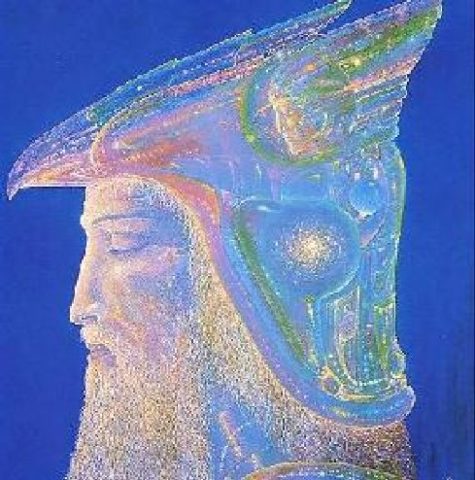
- Also known as: Oller, Ull, Uller, Ullr, Vuldor
- Origin: Norse:
- Rune: Ihwaz
- Tree: Yew (Holler’s home is Ydalir, Yew Tree Valley)
- Favored people: Holler likes the ladies. Skiers love Holler and he seems to love them right back.
Holler is the Lord of Frost and the King of Winter. He is a particularly primordial Norse deity, a mysterious, shadowy spirit. It’s unclear exactly where he sits on the Aesir / Vanir spectrum. Holler may be the son of Sif, the Golden-Tressed One. His father, if any, is unknown, although some suggest that he is of Frost Giant descent.
Holler’s name may be related to “glory.” He seems to have been venerated throughout Scandinavia, the Germanic lands, and the British Isles. According to some myths, when Odin goes wandering, he leaves Holler in charge of Asgard.
Holler is a master archer and hunter and a brilliant skier. Holler skis through the heavens, leaving stars in his wake. He controls the Aurora Borealis. Holler is the lord of justice and dueling. Allegedly invoking his name before a duel brings good luck. When he’s not zipping over the snow on his skis, Holler travels in a ship made from bone.
Holler the Hunter has associations with death. His sacred tree, the yew, is a funerary tree, found in grave yards, not least because of its poisonous berries. Holler may have hunted with poisoned arrows. He may be married to Hulda, weather goddess of birth and death. Like her, he is now associated with the Wild Hunt, and a more negative connotation as the God of Death, Disease and Devastation. It is said that he drags the doomed to his darkest dungeon and delights in dealing out disaster and destruction.
Post-Christianity, many of his more benevolent functions seem to have been transferred to Saint Hubert.
Source: The Encyclopedia of Spirits
- Also known as: Mother Holle, Frau Holle, Hulde
- Origin: Teutonic
- Realms: The sky, underground, mountains, wells
- Constellation: The Milky Way is the street she travels
- Elements: Earth, air, water
- Sacred animals: Wolves, Rabbits
- Color: White, blue
- Spirit Ally: Odin, with whom she sometimes leads the Wild Hunt
- Plants: Holly, elder, juniper, mugwort, flax, Sorcerer’s Violet (Vinca major – sometimes called Frau Holle)
- Sacred Days: The Winter Solstice is Hulda’s feast day. The twelve days between Dec 25 and Jan 6 are sacred to Hulda.
- Offerings: She loves music and dancing.
Manifestations:
A radiantly beautiful blond woman or a fierce old crone. In her guise as Queen of Witches, she has disheveled hair and a wild look.
She may also manifest as a woman when seen from the front but a tree from behind. She may be accompanied by an entourage of torch bearing rabbits who light her way.
About Hulda:
Hulda, a great and ancient goddess of birth and death, presides over a transit station for human souls, a crossroads between life and death. Hulda receives the souls of the newly dead into her realm and releases newborns to live new lives on Earth. Hulda bathes at midday in a fountain from which babies emerge, a well of life.
She was no unknown spirit but a prominent Northern European goddess. Holland is her namesake. Her name may be related to “holy.” Hulda lives in mountain caves and among elder trees, portals to her realm. Her realm may also be accessed via wells. She is sometimes witnessed walking alongside rivers or mountain paths, alone or accompanied by an entourage of rabbits and Fairies. She may be Queen of the Elves.
She plays a prominent part in German folk-lore and superstition. In stormy nights she can be often heard flying through the air, accompanied by weird spirits and witches. On such occasions it is dangerous for ill-doers to be abroad, as they will surely meet with severe punishment; while to the good she frequently appears as a benefactor. Her particular season is winter.
Hulda is a weather spirit. When she shakes her feather bed, it snows on Earth. Rain falls from her laundry rinse water. Fog hovering over a mountain may be smoke from Hulda’s fire. She guards and nurtures all the growing things of the forest. She was a culture-goddess, too, credited with introducing flax to Europe and teaching the art of making linen.
Banished after official conversion to Christianity, people were forbidden to venerate or contact Hulda. Those maintaining that practice were branded witches. Hulda was reclassified as a demon witch-goddess who attacked and harmed children.
She retains dominion over Pagan babies. People were urged to baptize their babies lest they end up in Hulda’s realm. Mother Holle, once so benevolent was transformed into a monster. People warned their children that if they weren’t obedient, Hulda would “get” them.
Vestiges of rituals invoking Hulda’s blessings on baby girls were retained by Ashkenazi Jews (the Hollekreisch), whether because Pagan women found discreet safety in that community rather than convert to Christianity or because Jews perceived Hulda’s resemblance to Lilith. Although rituals survive, many would be shocked and horrified to realize that they invoke a Pagan goddess.
Like Lilith, Hulda is not always so benevolent these days. She is a proud and resolutely Pagan spirit with little patience for hypocrites. Hulda can bestow fertility but she can take it away, too. She has power over storms, raising them as well as soothing them. She can be ambivalent toward people as demonstrated by Mother Holle, the Brothers Grimm fairytail in which she stars.
The theme involves young girls who wander into Hulda’s domain, either inadvertently or deliberately in anticipation of a reward. She rewards the girl who respects her and follows her commands with effort and devotion but causes excrement to rain down upon the lazy, disrespectful girl.
Found in:
- Encyclopaedia of Superstitions, Folklore, and the Occult Sciences
- The Encyclopedia of Spirits
Hekate is an exceptionally powerful spirit. She holds dominion over life, death, regeneration, and magic. She rules wisdom, choices, expiation, victory, vengeance, and travel. Hekate guards the frontier between life and death. She is an intermediary between the spirit world and that of humans. She is the witness to all crimes, especially those against women and children.
Hekate (Hecate) is Queen of the Night, the Spirit World, and Witchcraft. Her epithets include:
- She Who Works Her Will
- The Most Lovely One
- Influence From Afar
- Three Headed Hound of the Moon
- The One Before The Gate
- Light Bringer
Although today most associated with Greek mythology, her name, meaning “influence from afar,” acknowledges her foreign origins.
Generally believed to have first emerged in what is now Turkey, she was not an obscure goddess. Hekate was at one time chief deity of Caria, now western Turkey, and was eventually widely worshiped throughout Europe, Western Asia, and Egypt. Records of formal worship date from eighth century BC to the fourth century AD, although as magic fell from grace she became an increasingly disreputable spirit. All Hekate’s myths clearly identify her as a witch and matron of magical arts.
Hekate is renowned for her expertise with plants and her knowledge of their magickal and healing powers. A famed magickal garden was attached to her temple in Colchis on the Black Sea, now in modern Georgia. Some scholars suggest that an ancient Greek women’s guild, under the divine matronage of Hekate, once had responsibility for gathering and storing visionary, hallucinatory and poisonous plants. The same work in Greek indicates “pharmacist,” “poisoner,” and “witch.”
Petitioning Hekate
Hekate is a goddess of life, death, regeneration and magick. She rules wisdom, choices, expiation, victory, vengeance, and travel. She is witness to every crime.
- She is invoked for justice, especially for sexual crimes against women and girls.
- Hekate is invoked when justice is not forthcoming from other channels.
- Hekate has the power to grant or deny any mortal’s wish.
- She may be invoked for protection for dogs and from dogs.
- Hekate is petitioned for fertility, especially for female children.
- She brings victory in battle.
- Hekate may be invoked for healing, especially if medical solutions have failed.
- She may be petitioned for swift, painless death.
- Hekate can banish ghosts – or produce a ghost infestation.
Hekate typically responds to petitions via visions and dreams. If lost at a crossroads, literal or metaphoric, invoke her name and then pay attention to signs from her. She can be a shadowy, oblique goddess: her response may be subtle. Look for her animals: snakes, dragons, cats, and especially dogs.
- Favored people
Midwives, witches, healers, herbalists, dog lovers and rescuers. She is the matron of women in general and protects those who ride horses.
A Living Altar
Hecate is most famous today as a Dark Moon Spirit and Queen of Witches. Those are but two aspects of this multifaceted deity. Hecate was once the chief deity of the Carian nation, now in Western Turkey. She is matron of the city of Istanbul. She has dominion over life and death and makes the journey in between, indicating her power as a healing deity. Hecate is matron of midwives and herbalists.
Her priestesses (the most famous was Medea) were trained herbalists. Those in need of healing or solace journeyed to the gardens attached to Hecate’s shrine in Colchis on the Black Sea, home of the Golden Fleece pilfered by the Argonauts.
Hecate’s assistance may also be accessed by building a living altar in her honor. Plant a garden outdoors or create a living altar inside with potted plants. Add some or all of the following:
- Dog roses,
- Garlic,
- Lavender,
- Mandrake,
- Queen of the Night,
- Roses,
- Thorn apple,
- Tuberoses.
Hecate’s trees include:
- Black poplar
- Date palm
- Pomegranate
- Willow
- Yew
Place votive images of Hecate, together with her favorite creatures – dogs, dragons, and snakes – in the garden. To petition Hecate directly or to receive spontaneous magical inspiration regarding your healing needs, sit in or beside your living altar in the dark.
To Summon Hekate
Hecate, Queen of Witches, maintains office hours only at night: formal petitions and invitations must be offered after dark. A particularly ancient spirit, the only source of illumination she favors is fire.
Summon Hecate at night by a three-way crossroads. Ideally, light your way with a mullein torch. Offer her garlic, lavender, and honey. If you have a dog, bring it with you. Keep an eye on the dog; it’s likely to perceive Hecate before you do.
Why would you wish to contact Hecate?
Because she can teach you to do anything with magic. Because she can grant you enhanced psychic powers, fertility, romance, protection, freedom from illness, and magical restitution for any crime committed against you.
Hekate has been with us for at least three thousand years.
She was a liminal goddess who was present at all the boundaries and transitional moments in life. She was also an ‘evil-averting’ protector and guide. Her triple form emphasized her power over the three realms, these being the heavens, sea, and earth. Her primal nature was seen in the many animal heads she was depicted with, each emphasising different qualities of her manifold character.
Some of her well known titles include:
- Chthonia – earthy one
- Dadouchos – torch bearer
- Enodia – of the ways
- Kleidouchos – key bearer
- Kourotrophos – child’s nurse
- Phosphorus – light bearer
- Propolos – companion
- Propylaia – before the gate
- Soteira – savior
- Triformis – three bodied
- Trioditis – of the three ways
To enhance your ability to summon Hecate, try this:
Dry dandelion roots, then slice and pierce them to create beads, forming a ritual necklace to wear when calling Hecate. Call – or think – Hecate’s name as you pierce, string, and knot each bead. For best results, string the necklace at night by firelight.
Another way to enhance your relationship with the Queen of the Night is to practice the Silence of the Night Meditation. It’s a very simple yet profoundly powerful meditation, especially when practiced for an extended period of time.
Manifestations
Hekate has been known to assume the shape of a black cat, a bear, a pig or a hen but most typically manifests as a mature woman or black dog. She has a particularly strong bond with dogs. Even when manifesting in human form, Hekate is usually accompanied by hounds. Somehow there will be a canine reference. When manifesting as a woman alone, Hekate often circles in the manner of a dog.
Artistic renderings of Hekate usually attempt to capture her spiritual essence. She may be depicted with three bodies, each facing a different direction. One hand holds the knife that is the midwife’s tool, another holds a torch to illuminate the darkness, the last bears a serpent representing medical and magical wisdom. Sometimes Hekate is depicted with a woman’s body but three animal heads – those of a dog, a horse, and a lion.
Hekate, Queen Witch, is a shape-shifter supreme. While her usual manifestations are as a black dog or mature woman, she may manifest as a haggard, decrepit crone or a sexy, elegant, seductive woman. She even has an occasional mermaid manifestation. She may wear snakes in her hair. Every now and then, she appears as a black cat, snake, or dragon.
Sacred to Hekate
Hekate’s sacred time is black night. All her festivities and ceremonies are held after dark, the only acceptable illumination is candles or torches. She only accepts offerings and petitions at night. Hekate is identified with the Dark Moon, the time of her optimum power.
The last day of each month is dedicated to Hekate. She also shared a festival with Diana on August 13th in Italy. Modern Wiccans, for whom Hekate is an important deity, celebrate November 16th as Hecate Night of the Crossroads.
- Animals: Black ewe lambs, Boar, Bull, Cats, Cock, Cow, Dogs, Dragons, Fish, Goats, Horses, Lions, Mice, Mullet (fish), Polecat, Rams, Serpents, Toads, Wolf
- Attributes: Key, Cauldron, Broom, Torch, Knife
- Bird: Stork
- Color: Black, also Red, White, Yellow
- Emblem: Star and crescent moon
- Food: Eggs, Honey, Amphiphon Cakes (a cheesecake with lighted candles stuck into it)
- Fruit: Pomegranate
- Minerals: Copper, Gold, Loadstone, Meteorite, Sapphire
- Mount: Dragons pull her chariot
- Number: Three
- Planets: Moon (especially the dark moon), and Sirius, the Dog Star
- Plants and herbs: Aconite, Anise, Belladonna, Garlic, Grain, Henna, Lavender, Mandrake, Onion, Poppy, Saffron,
- Symbols: Dagger, Keys, Horned Crescent, Pegasus, New Moon, Three-Way Crossroads, Trident, Twin Torches
- Trees: Apples, Black poplar, Date palm, Oak (leaves), Pomegranate, Willow, Yew
Her sacred place is the crossroads, specifically three-way crossroads. Among her name is Hecate Trivia. That doesn’t indicate that Hekate is trivial or that worshiping her was a trivial pursuit: Trivia literally means “three roads.” Hekate is Spirit of the Crossroads: her power emanates from their point of intersection. Hekate’s image was once placed in Greek towns wherever three roads met.
Hecate is the Goddess of the dark of the moon, the black nights when the moon is hidden. She was associated with deeds of darkness, the Goddess of the Crossways, which was held to be ghostly places of evil magic, an Awful Divinity,
“Hecate of hell
Mighty to shatter every stubborn thing.
Hark! Hark! Her hounds are baying through the town.
Where three roads meet, there she is standing.”
Rituals
Hekate’s ancient devotees held dinners in her honor, known as Hekate Suppers. Foods associated with her were prepared. The entree was usually fish, especially red mullet. Devotees feasted and celebrated. Offerings and leftovers were placed outside the door or at a crossroads for Hekate and her hounds.
- The last day of each lunar month is dedicated to Hekate.
- Friday the 13th – particularly if it falls in the month of August.
- November 16th is Hekate Night
- August 13th, in Italy, a festival is shared between Diana and Hekate
Even way back when, cynics scoffed that food placed outside was actually consumed by feral dogs and homeless people without realizing that this is Hekate’s intent: this is one way she accepts offerings. (The Church was still trying to eradicate this ritual as late as the eleventh century.)
Smaller, private offerings may be left at a crossroads, too:
- Place offerings on a plate or flat stone and leave them at a crossroads after dark.
- Make your invocation and then walk away without looking back.
- Do not return for the plate, or any part of the offering, but consider it part of your gift.
Offerings can include the following:
- Eggs
- Garlic and honey (especially lavender honey)
- Croissants and crescent shaped breads and pastries
- Candles
- Incense
- Images of dogs, especially black dogs
- Actions on behalf of dogs
Encountering or hearing a dog is an indication that your petition has been heard.
The Mythology
According to myth, Hekate once served as an Angelos, a messenger for the other deities. She stole Hera’s beauty salve to give to her rival Europa. Hera enraged, pursued Hekate, who fled first to the bed of a woman in childbirth, then to a funeral procession, and finally to Lake Acheron in Hades where she was cleansed by the Cabeiri. Hekate emerged more powerful than ever, a goddess of birth, death, and purification. She rules passages between realms of life and death and is thus invoked by necromancers.
Hekate is most prominent in Greek mythology for being the sole deity to voluntarily assist Demeter in her search for her abducted daughter, Persephone. Later, after Persephone eats Death’s six pomegranate seeds and is condemned to spend half the year in Hades, it is Hekate who accompanies her as Lady-in-Waiting. In some legends, she even becomes Hades’ co-wife. Ceberus, three-headed hound of Hades, may be Hekate in disguise.
Hekate becomes Persephone’s link to her mother and the land of the living. She guarantees that Death cannot break the bond between mother and daughter. Hekate is the Matron of Necromancy.
Hekate, daughter of the Titans Perses and Asteria, is older than the Olympian spirits. The eight-century BC Greek poet Hesiod writes that Hekate’s power dates “from the beginning.” Zeus was crazy about her: he eliminated all other pre-Hellenic deities (the Titans) but, having fallen madly in love with Hekate, he let her be.
Hekate is understood to be a triple goddess by herself, appearing as maiden, mother, and crone. She is also part of a lunar triplicity with Artemis and Selene, and also with Demeter and Persephone. Hekate dances in Dionysus’ retinue and is a close ally of Kybele.
Alongside her intense lunar identification, Hekate is also associated with the element of water: her first love affairs were with sea gods including Triton. Her great-grandfather was Pontus the Sea. Her maternal great-aunt was the sea monster Keto. Hekate is also related to the Gorgons and Sirens and may be the mother of Scylla, who was transformed into a sea monster by another relative, Circe. Prior to her transformation Scylla was a beautiful woman from head to waist, with canine hips terminating in a fish tale.
Hekate led a host of shape-shifting female spirits known as Empausas, whose usual manifestation was as a beautiful woman with one brass leg and one donkey’s leg; Hekate herself sometimes takes this form. The Empusas patrolled roads and apparently sometimes had fun terrorizing travelers. If one invoked Hekate, however, they left you alone.
Devotees feted the goddess by holding rituals known as Hecate’s Suppers at the end of each month at a crossroad. (The end of the month in lunar calendars corresponds to the Dark Moon, the new month begins with the first sighting of the new moon). The Church was still trying to eradicate Hecate’s Suppers in the eleventh century.
Post-Christianity, Hekate became among the most intensely demonized spirits, her very name synonymous with “witch”. Her symbols (toad, cauldron, broom) are inextricably linked with stereotypes of witchcraft. What were symbols of fertility became symbols of evil. Her sacred dogs were converted into the Hounds of Hell. This denigration served to camouflage Hekate’s origins as a deity of Healing and Protection.
An Interesting Historical Tidbit
Hekate was a goddess with an organized cult. In addition to Caria and Colshis, she had sanctuaries in Aigina and Lagina and a grove on the Aventine hill. She is the matron goddess and guardian of the city of Istanbul (previously called Byzantium and Constantinople).
Hekate is credited with saving that city from attack by King Phillip II of Macedonia in 304 BCE. His forces attempted to attack secretly during a dark moon but Hekate lit a crescent moon, creating enough light for the Byzantines to apprehend their danger and save themselves.
In gratitude, they began using her symbols (star and crescent moon) on their coins. The image still appears on the Turkish flag. The image predates Islam and was the official emblem of Byzantine Greeks.
Collected from various sources including Encyclopedia of Spirits
- Titles: Goddess of Abundance, Queen of Witches
- Also known as: Bertha; Perchta; Frau Berta; Eisen Berta, Berchtli
- Origin: Germanic
- Sacred plants: Holly, mayflower
- Sacred creatures: Crickets, swans, geese.
Bavaria is the ancient stronghold of Berchta, goddess of abundance. Allegedly whatever you give her will be returned many times over. Berchta rules a sort of transit area for souls, caring for and guarding those who died as babies. Depending on the version, they either stay in her garden forever or she tends them until they reincarnate and receive new life. She protects living children, too. German folk tales describe a beautiful lady dressed in white who mysteriously appears in the middle of the night to nurse babies.
Initially, Perchta was the upholder of cultural taboos, such as the prohibition against spinning on holidays. She was an immensely popular goddess, and so post-Christianity she was aggressively demonized by the Church as a Queen of Witches. People were told to baptize their babies because otherwise they’d end up in Berchta’s realm, not in Heaven. She is among the leaders of the Wild Hunt, usually leading a parade of unbaptized babies.
She evolved into a bogeywoman still invoked as a threat to make children behave before Yule. She allegedly punishes “bad children” but gives gifts to good ones.
This old story is as follows:
In the folklore of Bavaria and Austria, Perchta was said to roam the countryside at midwinter, and to enter homes during the twelve days between Christmas and Epiphany (especially on the Twelfth Night). She would know whether the children and young servants of the household had behaved well and worked hard all year. If they had, they might find a small silver coin next day, in a shoe or pail. If they had not, she would slit their bellies open, remove stomach and guts, and stuff the hole with straw and pebbles.
She was particularly concerned to see that girls had spun the whole of their allotted portion of flax or wool during the year. She would also slit people’s bellies open and stuff them with straw if they ate something on the night of her feast day other than the traditional meal of fish and gruel.
Berchta protects:
- Unbaptized babies
- Stillbirths, miscarriages, abortions
- Those driven to suicide by broken hearts or despair
- Dead souls who lack people to remember them
- Dead souls who have not received proper, respectful burial
The types of dead souls Berchta protects have a tendency to trouble the living by manifesting as destructive ghosts. Should you be afflicted by such a ghost, petition Berchta to soothe and remove it, escorting it to her realm, where it will be much happier.
- Manifestations
A beautiful woman with pearls braided into her gold hair. A white veil obscures her face, and she wears a long, white silk dress. She has another look too: an old decrepit hag with long, wild grey hair and disheveled clothes.
In many old descriptions, Bertha had one large foot, sometimes called a goose foot or swan foot. Grimm thought the strange foot symbolized her being a higher being who could shapeshift to animal form. He noticed that Bertha with a strange foot exists in many languages:
“It is apparently a swan maiden’s foot, which as a mark of her higher nature she cannot lay aside…and at the same time the spinning-woman’s splayfoot that worked the treadle”.
Because she sometimes manifests with one webbed goose foot, it is possible that Berchta may be the original Mother Goose. In the Tyrol she appears as little old woman with a very wrinkled face, bright lively eyes, and a long hooked nose; her hair is disheveled, her garments tattered and torn.
- Attributes
When she’s young and beautiful, she carries the keys to happiness in one hand and a spray of mayflowers in the other; as a hag, she carries a distaff.
- Realm
A subterranean palace with a fabulous garden where she welcomes souls of children who died in infancy.
She maintains other homes within hollow mountains.
- Spirit allies
Perchta travels with a retinue of spirits called Perchten. Christian legend says the devil rides in their midst, but this may indicate the presence of a male deity who accompanies her.
- Sacred time
Berchta is celebrated throughout the entire Yule season. Post-Christianity, Yule became synonymous with Christmas, but in its original Pagan context it was a lengthier season.
In German tradition, the Feast of the Epiphany (Jan 6) is Berchtentag – Berchta’s Day. The preceding eve is Berchtennacht. The festival is celebrated with processions characterized by grotesque masks.
- Sacred places
Berchtesgaden in the Austrian Alps means “Berchta’s Garden.” Many springs near Salzburg are named in her honor.
- Offerings
Leave offerings out for her on Epiphany Eve, the way offerings are left for Santa. Not milk and cookies, though. Berchta likes a hearty meal: herring and dumplings is her favorite. Give her schnapps or other alcoholic beverages.
A Goddess of Many Names
Perchta had many different names depending on the era and region: Grimm listed the names Perahta and Berchte as the main names, followed by Berchta in Old High German, as well as Behrta and Frau Perchta. In Baden, Swabia, Switzerland and Slovenian regions, she was often called Frau Faste (the lady of the Ember days) or Pehta or ‘Kvaternica’, in Slovene. Elsewhere she was known as Posterli, Quatemberca and Fronfastenweiber.
In southern Austria, in Carinthia among the Slovenes, a male form of Perchta was known as Quantembermann, in German, or Kvaternik, in Slovene (the man of the four Ember days). Grimm thought that her male counterpart or equivalent is Berchtold.
Regional variations of the name include Berigl, Berchtlmuada, Perhta-Baba, Zlobna Pehta, Bechtrababa, Sampa, Stampa, Lutzl, Zamperin, Pudelfrau, Zampermuatta and Rauweib.
Modern celebrations
In contemporary culture, Perchta is portrayed as a “rewarder of the generous, and the punisher of the bad, particularly lying children”.
Vestiges of devotion to Berchta survive in some Alpine villages where it is traditional to place offerings of food for her on rooftops so she finds them while riding by.
Today in Austria, particularly Salzburg, where she is said to wander through Hohensalzburg Castle at dead of night, the Perchten are still a traditional part of holidays and festivals (such as the Carnival Fastnacht). The wooden animal masks made for the festivals are today called Perchten.
In the Pongau region of Austria large processions of Schönperchten (“beautiful Perchten”) and Schiachperchten (“ugly Perchten”) are held every winter. Beautiful masks are said to encouraging financial windfalls, and the ugly masks are worn to drive away evil spirits.
Other regional variations include the Tresterer in the Austrian Pinzgau region, the stilt dancers in the town of Unken, the Schnabelpercht in the Unterinntal region and the Glöcklerlaufen (“bell-running”) in the Salzkammergut. A number of large ski-resorts have turned the tradition into a tourist attraction drawing large crowds every winter.
From: Encyclopedia of Spirits and Wikipedia
- Titles: Master of the Cemetery, Lord of the Dead
- Also known as: Bawon, Samedi, Bawon Sanmdi, Baron Saturday, Baron Sandi
- Colors: Black, also red and purple
- Day: Saturday
- Numbers: 3, 7, 21
- Classification: Lwa
- Consort: Madame Brigitte (Maman Brigitte)
- Venerated in: Haitian Vodou, Louisiana Voodoo, Folk Catholicism
- Feast: November 2
- Patronage: Death, tombs, gravestones, cemeteries, dead relatives, obscenities, healing, smoking, drinking, disruption, spirits
Baron Samedi is one of the loa of Haitian Vodou. He is the leader of the Barons and possibly the Gedes. He presides over a sprawling, confusing, complex clan of spirits. When people speak of the Baron, they tend to mean Baron Samedi. Baron Samedi literally means Baron Saturday, which may sound innocuous compared to Baron Cemetery, or Krininel, but Saturday was the one day when Christ was really truly dead, the day between the crucifixion on Friday and resurrection on Sunday. On Saturday, even Jesus must answer to the Baron, Lord of the Dead.
Baron Samedi is Grand Master of the Celestial Masonic Lodge of Vodou Spirits, a thirty-second degree initiated Mason. He is invoked to contact and communicate with the dead. He determines whether they can come visit or not. He may be petitioned to remove bothersome ghosts and invoked to ward off death.
He is noted for disruption, obscenity, debauchery, and having a particular fondness for tobacco and rum. Additionally, he is the loa of resurrection, and in the latter capacity he is often called upon for healing by those near or approaching death, as it is the only Baron who can accept an individual into the realm of the dead.
Baron Samedi spends most of his time in the invisible realm of vodou spirits. He is notorious for his outrageous behavior, swearing continuously and making filthy jokes to the other spirits. He is married to another powerful spirit known as Maman Brigitte, but often chases after mortal women. He loves smoking and drinking and is rarely seen without a cigar in his mouth or a glass of rum in his bony fingers.
Baron Samedi can usually be found at the crossroads between the worlds of the living and the dead. When someone dies, he digs their grave and greets their soul after they have been buried, leading them to the underworld.
He is a powerful healer and is especially sympathetic to terminally ill children. Baron Samedi rules the cemetery: no one can die until he gives permission for their grave to be dug. Baron Samedi is lewd, obscene, and vulgar, but he can be just and kind. He prefers that children live full lives before joining him in the cemetery.
Baron Samedi is the crossroads where sex and death meet. Spirit of the undying life-force, he may be petitioned for fertility. He is the guardian of ancestral knowledge and the link to your ancestral spirits. If one lens keeps popping out of your dark glasses, the Baron may be seeking your attention or offering his patronage.
Baron Samedi is syncretized to Jesus Christ as they share the symbol of the cross. It is possible that Baron Samedi’s associations with the cross may pre-date christianity. In Congolese cosmology, the cross is the symbol of the life cycle: death – birth – rebirth. He may also be syncretized to Saint Expedite, and with Saint Martin de Porres.
- Note:
Syncretized means to attempt to unite and harmonize especially without critical examination or logical unity.
Manifestations:
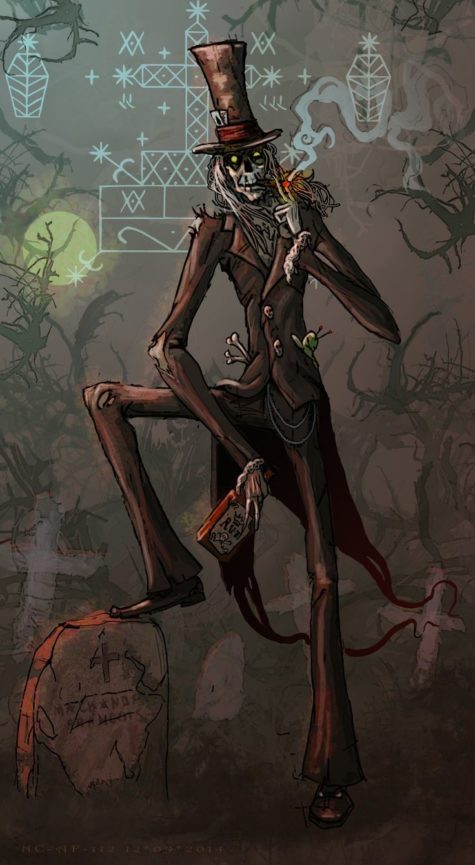 Baron Samedi manifests as an older, dark-skinned man in formal attire, dressed completely in black. He wears a black top hat, black suit, and may be smoking one of his beloved cigars. He wears impenetrable black sunglasses.
Baron Samedi manifests as an older, dark-skinned man in formal attire, dressed completely in black. He wears a black top hat, black suit, and may be smoking one of his beloved cigars. He wears impenetrable black sunglasses.
- The glasses may be missing a lens because he possesses two kinds of vision: he simultaneously sees the realms of the living and the dead.
- Alternatively his glasses have but one lens because a penis has but one eye and the phallus is his attribute (and because he loves sexual humor and innuendo.)
He is usually depicted with a top hat, black tail coat, dark glasses, and cotton plugs in the nostrils, as if to resemble a corpse dressed and prepared for burial in the Haitian style. He has a white, frequently skull-like face (or actually has a skull for a face), and speaks in a nasally voice. The former President for Life of Haiti, François Duvalier, modeled his cult of personality on Baron Samedi; he was often seen speaking in a deep nasal tone and wearing dark glasses.
- Favored People
Children; women seeking to conceive; funeral workers; grave diggers; those whose work brings them into contact with death.
Connection to other loas:
Baron Samedi is the leader of the Guédé, loa with particular links to magic, ancestor worship and death. Samedi is a loa of the dead, along with Baron’s numerous other incarnations Baron Cimetière, Baron La Croix, and Baron Kriminel. These lesser spirits, all dressed like the Baron, are all as rude and crude, but not nearly as charming as their master. They help carry the dead to the underworld.
Working with Baron Samedi
- Iconography: Baron Samedi’s throne is a chair chained to a cross. Images of Darth Vader are supposed to represent him (or just to decorate his altar; he likes toys)
- Attributes: Coffin; phallus, skull and crossbones; shovel; grave; black sunglasses; cross
As well as being master of the dead, Baron Samedi is also a giver of life. He can cure any mortal of any disease or wound, if he thinks it is worthwhile. His powers are especially great when it comes to vodou curses and black magic. Even if somebody has been afflicted by a hex that brings them to the verge of death, they will not die if the Baron refuses to dig their grave. So long as this mighty spirit keeps them out of the ground, they are safe.
He also ensures that all corpses rot in the ground to stop any soul from being brought back as a brainless zombie. What he demands in return depends on his mood. Sometimes he is content with his followers wearing black, white or purple clothes or using sacred objects; he may simply ask for a small gift of cigars, rum, black coffee, grilled peanuts, or bread. But sometimes the Baron requires a vodou ceremony to help him cross over into this world.
- Offerings
Black coffee, plain bread, dry toast, roasted peanuts. He drinks rum in which twenty-one very hot peppers have been steeped. Cigars, cigarettes, dark sun glasses, Day of the Dead toys, the sexier and more macabre the better; raise a skull and crossbones pirate flag for him, beautiful wrought-iron crosses are crafted in his honor.
- Veve
The veve or symbol for Baron Samedi is as follows:
Sources: Wikipedia and Encyclopedia of Spirits
The simplest definition of ghosts is that they are souls of the dead. Theoretically the word ghost encompasses all dead souls. However, dead souls who fade away and never reappear are memories, not ghosts. The word ghost implies that the dead soul maintains a presence in the realm of the living or perhaps refuses to leave.
Some ghosts may not realize they’re dead or may not know how to leave or where to go. In these cases, the living can intervene to help them transition via rituals, through shamans, or by requesting that a psychopomp escort the dead soul to safety.
Whether the presence of a ghost is intrinsically harmful is subject to debate. In some cultures, contact with ghosts is toxic to the living either because of mal-intent or just because contact with the dead is debilitating. Other cultures consider each ghost an individual case. Some are benevolent; some are lethal; others are just neutral presences having little effect one way or the other.
Some ghosts exhibit scary behavior, but many people find all ghosts frightening just because of their associations with death or the supernatural. No chain-clanking or nocturnal groaning is required; the ghost doesn’t actually have to do anything to cause fear other than be present.
Not all ghosts mean harm. Some simply enjoy lingering near the living. They do feed off human energy, tapping into the energy of individuals as if it were a power source: There’s a bit of a vampiric quality to this, but if not excessive it will not harm the average healthy individual. A ghost may actually be less energy-draining than some living “psychic vampires.”
Ghosts who linger without causing trouble can be tolerated. Some people enjoy the presence of ghosts. The reputed presence of ghosts is a selling point for many hotels, inns, and bed-and-breakfasts. Sensitive people can see ghosts, even if the ghosts don’t want to be seen. Put out an offering for them periodically. Make them feel welcome and this type of ghost can transform into an ally or be helpful in emergencies.
Some ghosts remain on the earthly plane because they are caught in a time warp: they constantly relive a tragedy that they experienced while alive. Some ghosts won’t leave because they have a mission. It may be to protect someone, to reveal information, or to seek revenge. Some ghosts are consumed with rage and resentment.
Raging ghosts who loathe and envy the living are dangerous ghosts. The most powerful can manifest in corporeal form and harm the living. Ghosts who are powerful enough to exert their individuality often transcend ghost status to become spirits. If honored and propitiated, even hostile ghosts can sometimes be persuaded to use their power benevolently.
Spirit mediums channel dead souls for benevolent purposes. Seances invite participation of dead souls so that they can provide information, comfort, and healing. Some dead souls, however, possess the living for their own selfish or destructive purposes. These must be exorcised or somehow made to leave.
Various spirits are renowned ghost busters. Sometimes even an image or amulet bearing their name is sufficient to send ghost packing. See the Ghost Busters page.
If a ghost can’t be exorcised, it can be distracted. Many ghosts, like low-level demons, demonstrate obsessive-compulsive behavior. Scatter tiny poppy or millet seeds. The ghost may feel compelled to pick up or count each and every one.
- Hanging up a many-holed sieve or fish net may have the same effect.
- Alternatively leave a ghost some thread and a needle with a broken eye. Some ghosts will spend eternity attempting to thread the needle, in the process, ceasing their depredations.
How someone died may effect what type of ghost they become. Allegedly those who die suddenly, violently, or before their time are more likely to become malevolent ghosts. In many parts of the world, the most feared ghost is a woman who died in childbirth. It’s crucial to point out, however, that not everyone who dies violently becomes a harmful ghost. Clearly most murder victims do not transform into rampaging supernatural beings, or there would be far less murder. It is not entirely clear why some victims of violent crimes turn into benevolent helpers while others become utterly consumed with rage and anger toward the entire world.
Various botanicals are said to discourage the presence of ghosts, especially rue and garlic. See the post on Ghost Busting with Botanicals for a more extensive list.
From: Encyclopedia of Spirits

